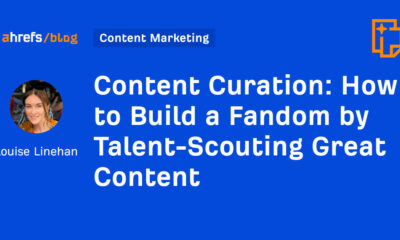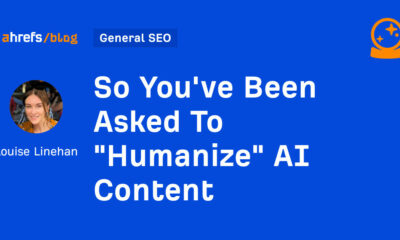SEO
What Is Dynamic Content And How Can I Use It?
Some users may be ready to buy while others need more information or prefer to browse and compare sites. Dynamic content allows you to reach all those people in real-time.
But what is it, and where does it fit in your marketing mix?
Dynamic content is content on a webpage, email, or ad that changes based on a user’s behavior.
Using a content management system (CMS), you can predefine user behaviors that will signal the content to adjust.
These user behaviors include:
The CMS then matches user behavior to the appropriate content.
Then, as users engage with your site or other marketing assets, the CMS triggers relevant content to drive them down the buyer’s funnel.
A typical example of dynamic content is online retail sites. Users see recommended products, emails about abandoned carts, or ads for relevant products.
Dynamic Content vs. Static Content
Static content is the opposite of dynamic content: these are the website pages that stay the same, no matter who views them.
Specifically, dynamic content:
- Can be personalized.
- Is database-driven.
- Is a more user-friendly experience.
On the other hand, static content:
- Is stored on HTML files.
- Doesn’t change or recognize behavior.
- Doesn’t take long to create.
For smaller websites, like portfolios, it may be beneficial to use static pages because there is less content for the user to sift through.
Additionally, many website editors use dynamic and static content simultaneously.
For example, their homepage and blog could be dynamic, but their pricing page is static since that information never changes.
Benefits Of Dynamic Content
Dynamic content can provide valuable information to site editors based on user behavior. Some benefits include:
- A personalized experience: By creating a customized experience for each type of customer, you can help build trust and relevancy.
- Guided buyer’s journey: Dynamic content can help guide users through the buyer’s funnel organically since they have the content they need to make a buying decision.
- Relevancy: Since users are served relevant content, dynamic content reduces the bounce rate.
- Automatic: Once you set up dynamic content, you do not need to monitor it.
- Engagement: User preferences are loaded once the site is revisited, which creates a faster experience for the user.
Additionally, customers respond well to dynamic content. Some statistics include:
- Emails with personalized subject lines are 26% more likely to be opened.
- 80% of consumers are more likely to do business with a company that offers personalized experiences.
- 52% of customers expect personalized offers.
Dynamic Content Examples
As an active internet user, you’ve encountered websites or other dynamic types of content.
Common examples of dynamic content include:
- Personalized email subject lines.
- Recommended products on ecommerce sites.
- Ads promoting products you were previously browsing.
- Special prices based on location.
- Abandoned cart emails.
When marketers use content like the examples above, they gather valuable pieces of information, such as:
- How many times does a user visit a website?
- What pages do users see, and how long do they stay?
- What products have users previously viewed or bought?
- What keywords brought the user to a website?
This information can help marketers provide a more customized experience for users.
Dynamic Content Strategies
Like all marketing strategies, dynamic content should have a purpose on your site.
Before you implement any dynamic content, you’ll want to ask how it will help customers navigate your site. Consider questions such as:
- What am I trying to get the customer to do?
- What type of content will be most helpful?
- What path do I want the customer to take?
- How does the customer interact with my brand (i.e., social media, search, email)?
These questions can help guide a more meaningful and purposeful strategy to create a better customer experience.
Special Offerings
You can use dynamic content to serve new offerings with downloadable offers.
For example, you have an eBook download that you’ve offered to customers.
Dynamic triggers can suggest an alternate offering if they’ve already downloaded the eBook.
Additionally, you can provide different form fields to other customers to gather more information. You can use this information to understand what offers to deliver.
Guide People Down The Funnel
As marketers, we must ensure potential customers are getting the necessary information to make a buying decision. Dynamic content can help.
Behavior from previous visits can ascertain a user’s intention and point to content that can guide them toward a buying decision.
An excellent example of this is an email nurturing campaign.
These campaigns are based on content the user previously visited.
Then, marketers send related content to the user, hoping it will help them make a purchase decision.
Give More Access To Repeat Customers
Do you have numerous amounts of content to give, but it’s hidden behind a form?
While this is a great lead generation tactic, you may see repeat customers filling out forms repeatedly to gain access.
However, you have all their information if they’ve already filled out a form.
Instead of making your loyal customers fill out endless forms, you can use dynamic content to recognize repeat customers.
This action can help them bypass the form and get straight to the content.
Provide Different Content
Dynamic content can help you remain relevant to many different customers based on location and need.
For instance, if you are a clothing website, you can create other images and page content that speaks to a customer in a high desert area while also serving content to a customer in a much colder climate.
Additionally, if you have a blog, you can serve more relevant articles to the user based on previous data.
For example, say a user has been looking at blogs concerning link building.
Dynamic content can use that data to serve them more link-building topics the next time they visit the blog.
Serve Targeted Ads
Some ads follow you around. This is another form of dynamic content.
These ads use your search behavior to serve users relevant products.
You can also use these targeted ads for downloadables, ebooks, event reminders, or other demographics.
Dynamic content can help you uncover multitudes of information about your customers.
However, more importantly, it can create a custom experience for users that keeps relevant content in front of them.
This strategy creates a more personalized and tailored web experience to increase repeat customers.
More resources:
Featured Image: Roman Samborskyi/Shutterstock
!function(f,b,e,v,n,t,s)
{if(f.fbq)return;n=f.fbq=function(){n.callMethod?
n.callMethod.apply(n,arguments):n.queue.push(arguments)};
if(!f._fbq)f._fbq=n;n.push=n;n.loaded=!0;n.version=’2.0′;
n.queue=[];t=b.createElement(e);t.async=!0;
t.src=v;s=b.getElementsByTagName(e)[0];
s.parentNode.insertBefore(t,s)}(window,document,’script’,
‘https://connect.facebook.net/en_US/fbevents.js’);
if( typeof sopp !== “undefined” && sopp === ‘yes’ ){
fbq(‘dataProcessingOptions’, [‘LDU’], 1, 1000);
}else{
fbq(‘dataProcessingOptions’, []);
}
fbq(‘init’, ‘1321385257908563’);
fbq(‘init’, ‘239948206198576’);
fbq(‘track’, ‘PageView’);
fbq(‘trackSingle’, ‘1321385257908563’, ‘ViewContent’, {
content_name: ‘dynamic-content-how-to’,
content_category: ‘marketing strategy-digital ‘
});



















You must be logged in to post a comment Login